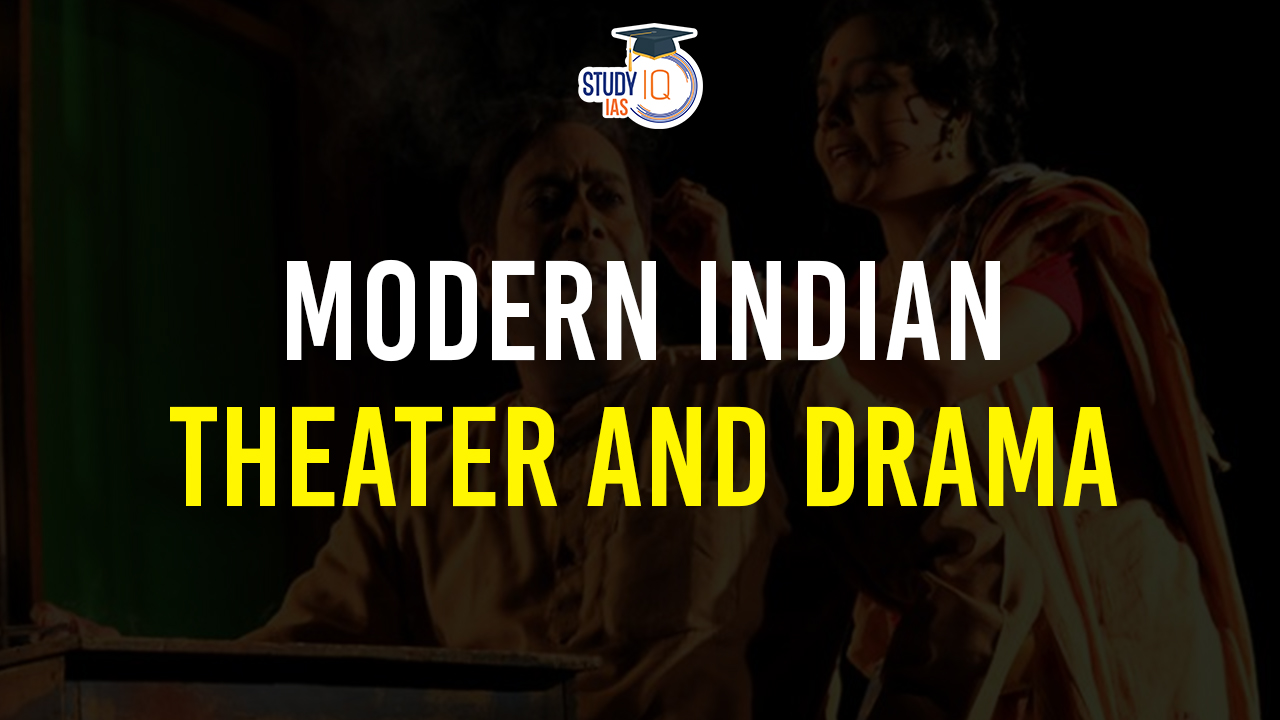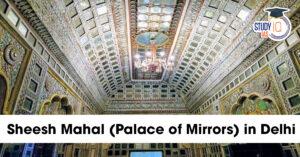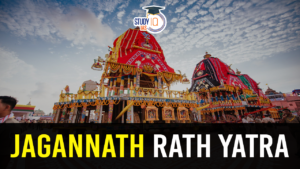Table of Contents
Modern Indian theater, shaped by the convergence of Sanskrit, folk, and Western traditions, finds its foundational roots in the latter. Emerging in the 19th century, it grappled with pressing issues of nationalism, self-identity, and modernity. The Western influence, particularly through realism and naturalism, brought new dramatic techniques. Playwrights like Tagore addressed these themes, fostering a cultural awakening. As a dynamic amalgamation of ancient heritage and global perspectives, modern Indian theater explores diverse narratives, reflecting the complex socio-cultural landscape of India. This synthesis of traditions continues to evolve, contributing to the vibrant tapestry of India’s theatrical expression.
We’re now on WhatsApp. Click to Join
Modern Indian Theater
In 19th-century Calcutta, theaters like Belgachia Natyashala and Shobhabazar Natyashala emerged. During the British era, Indians fused Western and Indian styles, forging a distinctive theatrical identity. The inclusive past contrasted with the commercialization of theaters, introducing costs for attendees. Social issues like dowry and caste became prominent themes. Responding to heightened political awareness, the British enacted the Dramatic Performances Act in 1876. Parsi Theatres thrived from the 1850s, later transitioning to cinema in the 1930s.
The Indian People’s Theatre Association (IPTA), formed in 1943, left a lasting impact. Regional theaters, including Bengali and Maharashtra, gained prominence, with influential contributions from figures like Rabindranath Tagore and Prithviraj Kapoor. The Sangeet Natak Akademi, founded in 1952, aimed to nurture performing arts, and institutions like the National School of Drama and Kalakshetra Manipur played pivotal roles in preserving and advancing India’s theatrical heritage.
Historical Development of Modern Indian Theater
19th Century Beginnings
Modern Indian theater began to take shape in the 19th century with the efforts of pioneers like Raja Ram Mohan Roy. He used theater as a medium for social reform and cultural awakening.
The Parsi theater, which emerged in Bombay (now Mumbai), played a crucial role in popularizing modern theater. It often adapted Western plays and catered to a diverse urban audience.
Nationalism and Identity
The late 19th and early 20th centuries saw a surge in nationalist sentiments, and theater became a platform for expressing these ideas. Playwrights like Rabindranath Tagore, through works like “Red Oleanders” and “The Post Office,” explored themes of nationalism and individual freedom.
Social and Political Themes
Modern Indian theater grappled with contemporary social issues. Playwrights such as Vijay Tendulkar addressed topics like gender inequality, caste discrimination, and political corruption in their works.
Experimental Phase
The mid-20th century witnessed an experimental phase in Indian theater. Directors like Satyadev Dubey and Badal Sircar introduced innovative techniques, emphasizing the actor’s body and expression.
Themes in Indian Drama
Gods and Kings
- Traditional and mythological themes are prevalent in Indian drama, exploring the stories of gods, kings, and mythical figures. These narratives often carry moral and philosophical undertones.
History or Mythology
- Historical and mythological events serve as rich sources for Indian playwrights. The retelling of epics and historical sagas provides a cultural and moral backdrop for contemporary audiences.
Ordinary People and Morals
- Many Indian plays delve into the lives of ordinary people, addressing their struggles, moral dilemmas, and societal challenges. These works often provide a mirror to the complexities of everyday life.
Traditional Indian Theater Forms
Traditional Indian theater is a rich and diverse tapestry that encompasses various forms, each with its unique styles, storytelling techniques, and cultural significance. Some prominent traditional Indian theater forms include:
| Theater Form | Origin | Key Features | Themes |
| Bharatanatyam | Tamil Nadu | Classical dance with hand gestures and expressions | Mythological stories |
| Kathakali | Kerala | Stylized dance-drama with elaborate costumes | Epics like Mahabharata and Ramayana |
| Koodiyattam | Kerala | Ancient Sanskrit dramas, stylized performance | Sanskrit plays |
| Yakshagana | Karnataka | Folk theater with dance, music, and dialogue | Mythological stories |
| Nautanki | Uttar Pradesh | Folk theater with music, dance, and drama | Social issues and contemporary themes |
| Ramlila | Pan-India (festive) | Folk theater during Navaratri, Ramayana stories | Life of Lord Rama |
| Therukoothu | Tamil Nadu | Street theater with dance, music, storytelling | Social issues |
| Bhand Pather | Jammu and Kashmir | Satirical folk theater with humor and wit | Social commentary |
| Chhau Dance | Odisha, Jharkhand, Bengal | Dance with martial arts elements | Mythological stories |
| Tamaasha | Maharashtra | Folk theater with music, dance, and drama | Contemporary social issues |
Famous Personalities of Modern Indian Theater
Samsa (Sami Venkatadri Iyer):
- Samsa was a prominent Kannada playwright and dramatist known for his significant contributions to Kannada theater. His works often delved into social issues, and he played a crucial role in shaping the modern Kannada theatrical landscape.
Adya Rangachary:
- Adya Rangachary, another notable Kannada playwright, enriched the theater scene with his thought-provoking plays. His contributions have had a lasting impact on the cultural and literary aspects of Kannada drama.
Kuvempu (Kuppali Venkatappa Puttappa):
- Kuvempu, a towering figure in Kannada literature, was not only a poet and novelist but also an actor-playwright. His contributions to theater, coupled with his literary achievements, made him a multifaceted luminary in Karnataka’s cultural sphere.
Subrahmanya Bharathiar:
- A revered figure in Tamil literature and a freedom fighter, Bharathiar also made significant contributions to Tamil theater. His plays often reflected his nationalist ideologies and commitment to social reform.
Veeresalingam Pantulu:
- A social reformer and writer in Andhra Pradesh, Veeresalingam Pantulu’s literary works extended to theater. He used drama as a medium to address social issues and promote progressive ideas in society.
Sreekandan Nair:
- Sreekandan Nair, associated with Kerala, made noteworthy contributions to the Malayalam theater scene. His plays, marked by cultural richness, added to the vibrant theatrical traditions of the region.
Bharatendu Harishchandra:
- A key figure in the Hindi literary and theatrical revival during the late 19th century, Bharatendu Harishchandra is often hailed as the “Father of Modern Hindi Literature.” His contributions include both writing and promoting theater in Hindi.
Jaishankar Prasad:
- An influential figure in Hindi literature and theater, Jaishankar Prasad was associated with the Chhayavaad literary movement. His plays, marked by poetic richness, contributed significantly to the development of Hindi drama.
BV Karanth:
- BV Karanth, a versatile theater personality, made impactful contributions to theater in Andhra Pradesh, Karnataka, and Madhya Pradesh. His directorial skills and innovative approach to staging plays earned him acclaim.
KV Subbanna:
- Founder of the NINASAM (Neelakanteshwara Natya Seva Sangha) theater group, KV Subbanna is a celebrated figure in Kannada theater. His commitment to rural theater, education, and cultural activism has been recognized with awards, including the Ramon Magsaysay Award.
Indira Parthasarathy:
- A Tamil playwright and actor, Indira Parthasarathy is known for his significant contributions to Tamil theater. His plays often explore complex social and psychological themes.
Girish Karnad:
- A towering figure in Indian theater, Girish Karnad’s contributions as a playwright, actor, and director have left an indelible mark. Works like “Hayavadana” and “Tughlaq” are celebrated for their exploration of historical and mythological themes.
Habib Tanvir:
- An influential theater director and playwright associated with the Naya Theatre, Habib Tanvir played a key role in shaping the modern Indian theater landscape. His work often incorporated folk traditions and social commentary.
Vijay Tendulkar:
- Known for his powerful and socially relevant plays, Vijay Tendulkar addressed issues like gender inequality and social injustice. “Shantata! Court Chalu Aahe” and “Ghashiram Kotwal” are among his notable works.
Badal Sarkar:
- A prominent figure in the world of Indian theater, Badal Sarkar was known for his contributions to the concept of “Third Theatre,” a synthesis of traditional and commercial forms. His plays often engaged with contemporary social issues.
Vijaya Mehta:
- A theater director and one of the founders of Rangayan, Vijaya Mehta played a significant role in promoting experimental theater in India. She received acclaim for her directorial ventures both in India and abroad.
Dharmavir Bharati:
- An influential Hindi writer and playwright, Dharmavir Bharati is best known for his iconic play “Andha Yug,” a powerful exploration of the aftermath of the Mahabharata war.
Mohan Rakesh:
- A leading figure in Hindi literature and theater, Mohan Rakesh’s plays, such as “Ashadh Ka Ek Din” and “Leheron Ke Rajhans,” are considered milestones in modern Hindi drama.
Chandrashekhar Kambar:
- A renowned Kannada poet, playwright, and folklorist, Chandrashekhar Kambar’s contributions to Kannada theater have earned him accolades. He is known for blending traditional folk forms with modern theatrical elements.
P Lankesh:
- A versatile personality, P Lankesh was a renowned Kannada playwright, poet, journalist, and filmmaker. His plays and writings often addressed social issues and reflected the cultural ethos of Karnataka.
Modern Indian Theater and Drama UPSC
Modern Indian theater, rooted in Sanskrit, folk, and Western traditions, emerged in the 19th century, grappling with nationalism and identity. Western influences introduced realism, shaping playwrights like Tagore. Calcutta’s theaters commercialized, addressing social issues, and the British enacted the Dramatic Performances Act in 1876. Parsi Theatres thrived, and IPTA, formed in 1943, left a lasting impact. The Sangeet Natak Akademi, was founded in 1952, and institutions like the National School of Drama played pivotal roles. In the 19th century, pioneers like Raja Ram Mohan Roy and the Parsi theater laid the foundation for modern Indian theater, addressing social, political, and experimental themes.


 Sheesh Mahal in Delhi Restoration, Archi...
Sheesh Mahal in Delhi Restoration, Archi...
 Bonalu Festival 2025: Date, History, Rit...
Bonalu Festival 2025: Date, History, Rit...
 Puri Jagannath Rath Yatra 2025, History,...
Puri Jagannath Rath Yatra 2025, History,...





















